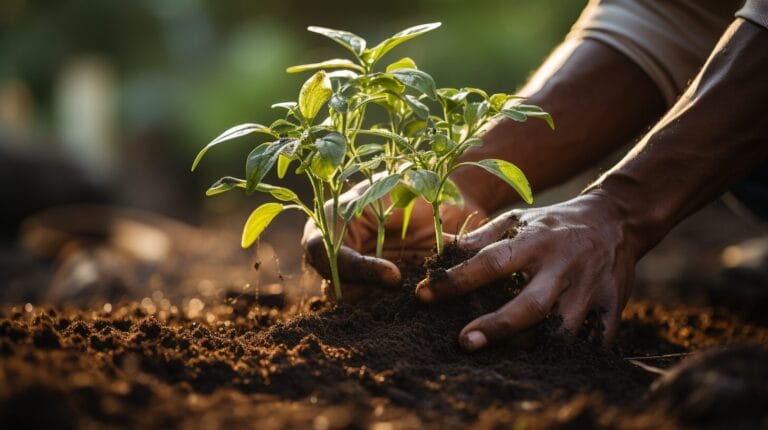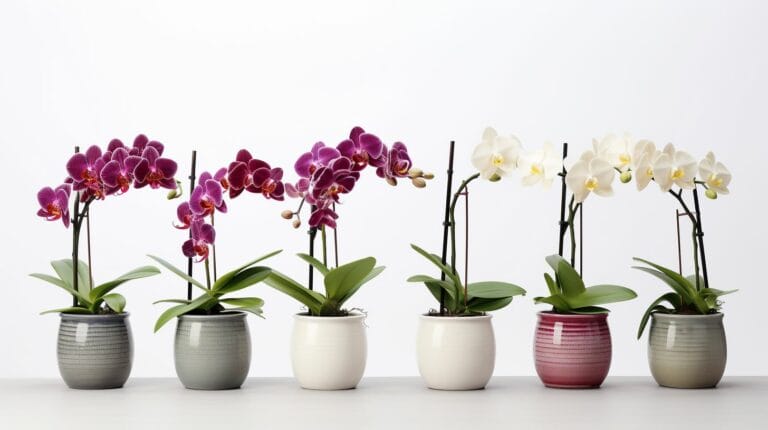Snake Plant Growth Rate: How Fast Do Snake Plants Grow Indoors?
Dive into the vibrant world of indoor gardening! Picture yourself surrounded by a captivating collection of plants that not only beautify your room but also cleanse the surrounding air.
One notable member of this botanical exhibition is the Snake Plant or Dracaena Trifasciata. With its vertical leaves and universally charming appeal, this plant has rightfully won the hearts of many indoor gardeners.
Do you find yourself spellbound by this elegantly verdant gem, wondering just how quickly it grows indoors? What factors might influence snake plant growth rate? This discussion seeks to answer these questions and more as we delve into the exciting growth patterns of the Snake Plant.
A surprising fact is that a snake plant can outlive two decades in optimal conditions! Let’s ready our green thumbs as we unearth more about this popular indoor companion.
Key Takeaway
- Snake plants, while slow-growing, can grow between two and twelve inches per year.
- The growth rate is influenced by factors such as light, water, temperature, soil conditions, and care regimen.
- Common hindrances to growth include overwatering, insufficient lighting, pests, diseases, improper soil, and unsuitable temperatures.
About Snake Plants
Snake plants, frequently called Sansevieria or Mother-in-Law’s Tongue, are popular indoor cultivars due to their distinct appearance and ease of care. They belong to the Asparagaceae family and originate from open grasslands deserts, alongside tall trees, and amidst small shrubs in Africa and Madagascar.
The snake plant’s long, sword-like leaves grow upwards, often exhibiting variegated yellow or silver stripe patterns. This unpretentious plant is renowned for its air purification capabilities and adaptiveness to low-light conditions.
Botanical Characteristics Video
Botanical Characteristics
Snake plants are uniquely characterized by their tall, pointed leaves, commonly adorned with green margins and a central stripe of yellow or white. Some varieties may exhibit silvery or golden hues! Every leaf sprouts upward from underground rhizomes, leading to propagation. Variations in leaf shape and size are based on the plant type. Still, its unmistakable charm is evident in each leaf.
Native Habitats
Snake plants are indigenous to the varied regions of Africa – from expansive grasslands to scorching deserts and beneath both tall trees and miniature shrubs. This versatile plant revels in various climates, from blazing sun to light shade. Its hardy nature allows it to endure both hot and cold environments, and it can even thrive without much water, closely emulating its native conditions.
How Fast Do Snake Plants Grow Full Size?

Snake plants are distinguished by their slow growth rate, expanding between two and twelve inches per annum. Its size is contingent on its growing space; given free rein, snake plants can grow impressively tall and wide, needing more sunlight compared to indoor conditions.
The plant’s growth speed is also influenced by its care regimen. Good lighting promotes faster, healthier growth, as does nutrient-rich soil. However, patience is essential when cultivating snake plants – typically, achieving full size takes five to ten years.
Contrasting species of snake plants exhibit disparate growth rates, with some taking longer to fully mature than others. All these factors collectively impact the rate at which your indoor or outdoor snake plants reach full maturity.
Awareness of the plant’s natural growth cycle is beneficial when caring for your snake plant at home. Remember, a pot’s size can also slow down the growth rate.
Avoid overindulging your sturdy plant – too much water or nourishment can result in sickness!
Snake Plant Growth Indoors

Snake plants, alternatively known as Sansevieria or mother-in-law’s tongue, are cherished houseplants due to their resilient nature and distinctive foliage. Several factors affect their indoor growth rate and development.
Factors Influencing Snake Plant’s Growth
The following elements profoundly influence the growth of a snake plant:
- Light: Snake plants prefer bright, indirect light for optimal growth but can also survive in low-light conditions. However, growth is notably slower in poorer lighting.
- Water: Overwatering can jeopardize its health. The plant prefers dry soil intervals between watering.
- Temperature: Snake plants’ ideal temperatures fall between 70 and 90 degrees Fahrenheit.
- Fertilizer: Use a balanced houseplant fertilizer during the growing period to nourish your snake plant effectively.
- Soil: Snake plants thrive best in well-draining potting mixes. This promotes dry roots, enhancing growth.
- Pot Size: Snake plants don’t require frequent repotting due to their slow growth. You’ll only need to repot every 2-3 years.
- Pruning and Care: Regularly removing old or damaged leaves encourages fresh, healthier growth.
Common Reasons That Stunt the Snake Plant Growth Rate
Overwatering
Overwatering results in waterlogged roots that cannot efficiently absorb oxygen, leading to diseases such as root rot and stunting growth. To promote health and growth, ensure the soil of your snake plant has ample time to dry between waterings.
Light Deprivation
Snake plants need bright, indirect light for optimal growth. Insufficient light slows down or stunts growth. Consider the changing light levels through seasons when caring for your snake plant. Remember the direct relationship between light availability and the growth speed of snake plants.
Pests and Diseases
Pests and diseases can hinder the health and growth of snake plants. Aphids, mealybugs, spider mites, and whiteflies are common pests that feed on snake plant leaves, causing damage. Diseases like root rot and southern blight can also affect growth. Consistent vigilance is critical to prompt detection and action to protect your snake plant.
Poor Soil Quality
Poor soil slows down or inhibits plant growth. To ensure optimal growth, choose a well-draining soil that does not retain excess moisture and prevents root rot, ensuring the health and prosperity of snake plants.
Incorrect Temperature
Inappropriate temperature ranges can thwart snake plant growth. Extreme and fluctuating temperatures can hinder growth. Ideal temperature conditions for snake plants lie between 60-85°F (16-29°C). Maintain a consistent, suitable temperature to encourage optimal growth.
Does the Growth Rate of Snake Plants Change Depending on Watering Practices?
Snake plants, also known as Sansevieria, are renowned for their hardiness. However, navigating snake plant’s water balance is crucial for optimal growth. Overwatering can lead to root rot, stunting the plant’s development, while underwatering can hinder growth. Striking the right balance in watering practices is key to promoting a healthy growth rate for snake plants.
How to Make a Snake Plant Grow Faster?
To expedite the growth of a snake plant:
- Provide optimal growing conditions.
- Start with well-draining soil to prevent root rot and stunted growth.
- Place the plant in an area with bright, indirect sunlight.
- Maintain a temperature between 70-90°F (21-32°C) and humidity levels of 40-50% for quicker growth.
Use a balanced houseplant fertilizer every two to three months during the growing season. If the snake plant becomes rootbound or outgrows its pot, replant it in a slightly larger container for new growth.
Optimal Soil for Snake Plants
It’s vital to use the correct soil type to maximize the growth of your snake plant. A well-draining soil is critical. Poor soil quality can retard or even halt the growth of these plants. Choose soil that facilitates easy water drainage and does not retain excess water to prevent root rot and keep your snake plant flourishing.
Ideal Light Conditions
Snake plants thrive in bright, indirect lights but can also withstand low light conditions. However, too much direct sunlight can scorch their leaves. The amount of light a snake plant receives directly affects its growth rate – more light equals faster growth. It’s worthwhile to note that snake plants may grow slower during winter due to shorter days and reduced sunlight availability.
Preferred Temperature & Humidity
Providing optimal temperature and humidity conditions fosters healthier and quicker snake plant growth. Snake plants flourish in temperatures between 70-90°F (21-32°C) and can withstand cooler temperatures down to 50°F (10°C), though growth may be slower. The snake plant prefers a humidity level of around 40-50%. Using a humidifier or placing a water-filled tray near the plant can help increase humidity, particularly during drier winter months when home heating systems are active.
Fertilization Strategy
Here are some timing and application strategies for fertilizing your snake plant:
- Choosing the right fertilizer: Opt for a balanced, water-soluble fertilizer with equal proportions of nitrogen, phosphorus, and potassium. Choose a brand specifically designed for indoor plants.
- Fertilizer application: Apply fertilizer during spring and summer, avoiding the slower-growing winter months.
- Fertilizer dilution: Abide by the guidelines on the fertilizer packet, diluting it in water as specified to avoid excessive concentrations that could harm the snake plant.
- Uniform fertilizer application: Pour the diluted fertilizer evenly on the soil around the plant base. Avoid contact with the leaves to prevent potential harm.
- Frequency of fertilizer application: Fertilize every two to four weeks during the active growing season, reducing or halting during the fall and winter when growth slows.
When and How to Repot Snake Plants
Knowing when and how to repot your snake plant promotes faster growth. Repotting your plant provides the roots with more space to grow and flourish. Here are some tips:
- Timings: It is best to repot during active growth in spring or early summer to allow ample recovery time before winter.
- Pot selection: Choose a pot slightly larger than the existing one, ensuring drainage holes to avoid water pooling.
- Soil type: Use well-draining soil meant for succulents or cacti. Heavy soils retaining excessive moisture may lead to root rot.
- Repotting process: Carefully remove the snake plant from its pot, lightly untangling any dense roots. Position the plant in a pre-soiled new pot at the same level as before and fill in more soil around the sides, gently securing it.
- Watering post-repotting: Water the plant thoroughly after repotting and when the top-inch soil layer has dried out to avoid overwatering and possible root rot.
Having learned about the surprising growth rate of snake plants indoors, you might now be curious: Can a snake plant live outside? Let’s explore the exciting possibilities of growing these resilient plants in an outdoor environment!
Conclusion
Understanding your snake plant’s growth rate is instrumental for proper care and maintenance. Snake plants mature slowly, usually between two to twelve inches per year, depending on factors like light, water, temperature, and soil conditions.
You can substantially expedite its growth rate by supplying the right conditions and care regimen – well-draining soil, bright indirect light, proper pots, and ideal temperature and humidity.
Remember, slow and steady wins the race. So take your time, understand its needs, and look forward to your foliage friend flourishing!
FAQs
How fast do snake plants grow indoors?
Snake plants are slow growers, expanding at a few inches per year when cared for appropriately in optimal conditions.
Why is my snake plant’s growth stunted?
Poor care practices can stunt the growth of your snake plant, such as overwatering, inadequate lighting, or the presence of leaf and root-damaging pests like aphids and mealybugs.
How often should I repot my snake plant?
As slow growers, snake plants necessitate infrequent repotting only when fresh growth has outgrown the current pot and needs additional root space.
Will more watering help my snake plant mature faster?
Contrary to this popular presumption, snake plants prefer drier soil conditions. Excess watering can result in slower growth or even root rot disease. They can grow well even with less frequent watering.
Does the snake plant type affect its growth rate?
Definitely! Different types of snake plants, like Dracaena trifasciata or Mother-in-law’s Tongue, have varying needs that influence their growth rates.
What are the characteristics of a healthy snake plant?
A healthy snake plant will regularly exhibit new green and upward growth with good care practices such as pruning old leaves, providing enough light, and avoiding overwatering.







